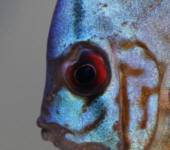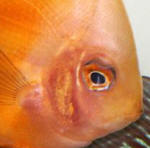It is becoming difficult to find quality Discus. The market is flooded with many poor quality Discus that attract buyers because of their lower cost but the Discus will discourage their owners from the first month and result in a loss of discus enthusiasts.
So, not only are quality Discus becoming scarcer but also Discus in general because of their reputation as a hard to keep fish caused by this poor quality.
Discus are like anything else, the more quality you put into them, the more beautiful they will be, but above all, the more reliable they will be and the fewer problems you will have.
But you still need to know how to recognize quality, that’s where we will help you.
Color
First rule, do not let you ever influenced by the color of the Discus.
A Discus normally begins to take color only from 2.5″-3″. A Discus having its whole body colored or is partially brightly colored at a small size is a sign of unnatural treatment such as dyes and hormones. In general, they will have a growth problem because once they leave the farm, they can no longer grow without the food supplements they had.
In addition, breeders of this type of Discus often use antibiotics in the feed to minimize disease and loss.
This will of course affect the health and fragility of your Discus in the long run. They will also often be infertile, unable to reproduce. So even if it looks beautiful and healthy, a Discus that is colored brightly too early will most likely not develop normally. Even an adult may not keep his vivid colors.
Beware also of colors that do not look natural. For example, a yellow Discus will turn orange unless you give it a special food that does not exist in the market.
Shape
A Discus should be round and that is after about the 1st month of his birth, about 1″.
Don’t believe if you are told it will round out when it is not round at 2″ or more.
A Discus with an elongated shape, longer than it is tall, is a sign of a poor quality Discus, either genetically or through poor nutrition.
Eye
The eye should be small, proportionate to its body with a round shape without defect.
A large eye is a sign of stunted growth caused by poor nutrition or worse, internal parasites in the intestines.
This is very rarely recoverable and these Discus will never grow normally and you will take a big risk because even if it does not look sick, this kind of Discus is less resistant to different diseases.
We see more and more Discus with deformed eyes like the example in the pictures below. These eyes are not necessarily due to a disease but more to a problem in the breeding. This kind of Discus has been bred in an unnatural way. In fact in all cases, these Discus develop this malformation at the buyer’s or shortly after leaving their breeding. So even Discus without this deformity and coming from the same breeder will be low quality Discus.
Bones
Its body should not show any bones such as the top of the skull or the ribs.
This is a sign of thinness.
Behavior
The Discus is originally fearful but after more than 60 years of breeding, they have lost this fear to get used to our aquariums, provided that the breeding is done properly.
Indeed, many Discus breeding are practiced in opaque plastic tanks and these Discus do not see humans through a glass as they will do at home in your aquarium. This is the main cause that will make the Discus you will see very often shy and hidden because they see a human for the first time in front of them.
This type of fearful Discus is stressed and therefore fragile, susceptible to various diseases.
There are of course many other causes such as the layout of the aquarium or the number of Discus but look at our videos where our Discus are in tanks without decoration and that we hit the windows: click here. These videos speak for themselves to prove that our Discus are used to aquariums, with a curious character.
Disease
When buying, make sure there are no signs of disease.
There are too many diseases for us to describe them all, but as a general rule, check that its eyes are clear and translucent, that its skin is nice and smooth, and that the fins are extended.
If you see these stools, make sure they are not white.
Fins
The case of the fins is very delicate because they are fragile and damaged fins do not necessarily reflect a bad quality of Discus. They can simply have been damaged by another Discus or a change of the parameters of water.
But it can also be a problem of disease or malformation that will show a bad quality of Discus.
It is thus necessary to know how to recognize and differentiate a malformed, sick or simply damaged fin.
The best is of course to take a Discus with whole fins of a beautiful form which will take part in forming a round Discus.
Notes
Quality often equals higher price but also success.
If a Discus doesn’t seem expensive to you, ask yourself the question of its quality.
With a quality Discus, you put all the chances on your side, but don’t forget that it will remain a beautiful Discus if its maintenance is also of quality.
Examples of bad quality
 Deformed eye Deformed eye |
 Deformed eye Deformed eye |
.jpg) Too colored for a 3″ Too colored for a 3″ |
.jpg)
.jpg)
.jpg)
.jpg)
.jpg)
.jpg)
.jpg)
.jpg)
.jpg)
.jpg)
.jpg)